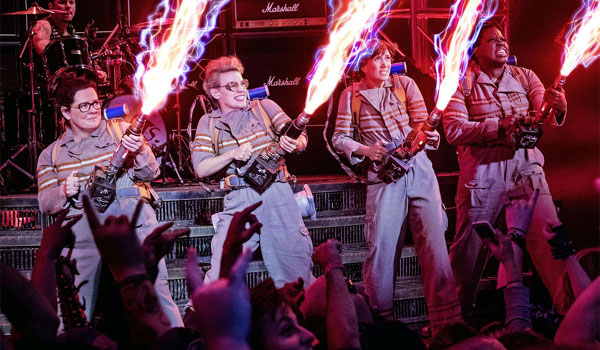There is a very simple problem with remaking Ghostbusters, and it has nothing to do with idiots thinking that their childhood is being ruined, or female characters taking lead roles once played by men. The problem with remaking Ghostbusters (as would be found redoing Back To The Future or The Godfather), is that the original is a timeless, cherished, bona fide classic, and no matter what was done with the material, the beloved first will still be the ultimate point of comparison, and a bar too high to reach. So to get it out of the way: No, Paul Feig's Ghostbusters is not as good as Ivan Reitman's 1984 hit. But it is still a fun blockbuster worthy of curiosity and delivering a great number of laughs.
Because it's a reboot instead of the increasingly more common decades-later sequel, Ghostbusters carries the issue of retelling a team origin story that the audience is already very familiar with, but skates by thanks to establishing characters who are genuinely not individually analogous to the traditional line-up. Things kick off with the introduction of Erin Gilbert (Kristin Wiig), an uptight professor of physics at Columbia University who is on the verge of getting tenure when she receives some career-threatening information: a book about ghosts that she co-wrote with her oddball paranormal scientist friend, Abby Yates (Melissa McCarthy), has begun gaining attention and selling copies. It's Erin's attempt to halt the proliferation of the paperback that leads her to: reunite with her old friend; meet Abby's new partner, the possibly deranged Jillian Holtzmann (Kate McKinnon); and start down the path of becoming a tan jumpsuit-wearing founding member of the Ghostbusters.
Shocked to discover authentic paranormal activity during an investigation, and joining forces with MTA worker and New York know-it-all Patty Tolan (Leslie Jones), the four ladies begin a mission to help the city get a handle on its growing ghost problem. What they don't know, however, is that there is a social misfit and fellow scientist named Rowan North (Neil Casey) roaming the streets and enacting a plan to try and create hell on Earth.
As we've seen from all of Paul Feig's films, his special skills rests in his ability to really coax out excellent performances from his talented leads and supporting staff, and he's on his game with Ghostbusters. There are spots that fall flat and don't work comedically as well as they should, but all four members of the titular team deliver fun, distinct performances, with McKinnon's Holtzmann being the standout with just the right combination of weirdness and enthusiasm. Between the four there is entertaining chemistry and also plenty of room to grow (if the franchise moves forward, as the studio very clearly wants it to do).
Feig also saw an opportunity in Ghostbusters to give basically every speaking part -- no matter how small -- to a talented actor and/or comedian, and from Zach Woods to Ed Begley Jr. to Michael McDonald, they all add something special (even as some of the special cameos wind up being underwhelming). The performance that everyone will be walking away talking about, though, is the one delivered by Thor himself, Chris Hemsworth. Playing a Hall Of Fame-level idiot named Kevin, hired as the Ghostbusters' office assistant based solely on his looks, the Australian actor slays moment to moment, showcasing ever expanding layers to his stupidity. There's little question that it will go down as one of the funniest comedic performances of 2016, and one could see it easily spring-boarding to more humorous roles for Hemsworth.
One certainly distinct stylistic difference between Paul Feig's Ghostbusters and Ivan Reitman's is the use of 3D -- and while that technology has essentially become old hat, the new movie actually makes better use of it than any other blockbuster in years. Other filmmakers have solely fixated on the use of enhanced depth with the third dimension, but what makes Feig's film stand out is the use of what is unquestionably the more fun side of 3D -- regularly having the footage break through the screen, while also enhancing the story being told. From rapidly-flying ghosts to out of control particle beams, the feature constantly has material flying at you (sometimes making special use of top and bottom black bars made available by the widescreen 2.35:1 aspect ratio), and what's even more impressive about it is the fact that the staging is done in such a way that the moments won't appear specially arranged in 2D versions and take you out of the big screen experience. It's one of the biggest surprises Ghostbusters has to offer, and a welcome one.
There will unquestionably be movie-goers whose experience is hampered by simply being entirely unable to mentally let go of the legacy of Ghostbusters, and the truth is that it can only be called the third best Ghostbusters movie. That's its cross to bear. But it also builds with solid pacing, features crafty and entertaining filmmaking style, and has a number of consistently funny performances from actors delivering lines you'll be quoting and chuckling about days later.
Your Daily Blend of Entertainment News

Eric Eisenberg is the Assistant Managing Editor at CinemaBlend. After graduating Boston University and earning a bachelor’s degree in journalism, he took a part-time job as a staff writer for CinemaBlend, and after six months was offered the opportunity to move to Los Angeles and take on a newly created West Coast Editor position. Over a decade later, he's continuing to advance his interests and expertise. In addition to conducting filmmaker interviews and contributing to the news and feature content of the site, Eric also oversees the Movie Reviews section, writes the the weekend box office report (published Sundays), and is the site's resident Stephen King expert. He has two King-related columns.

